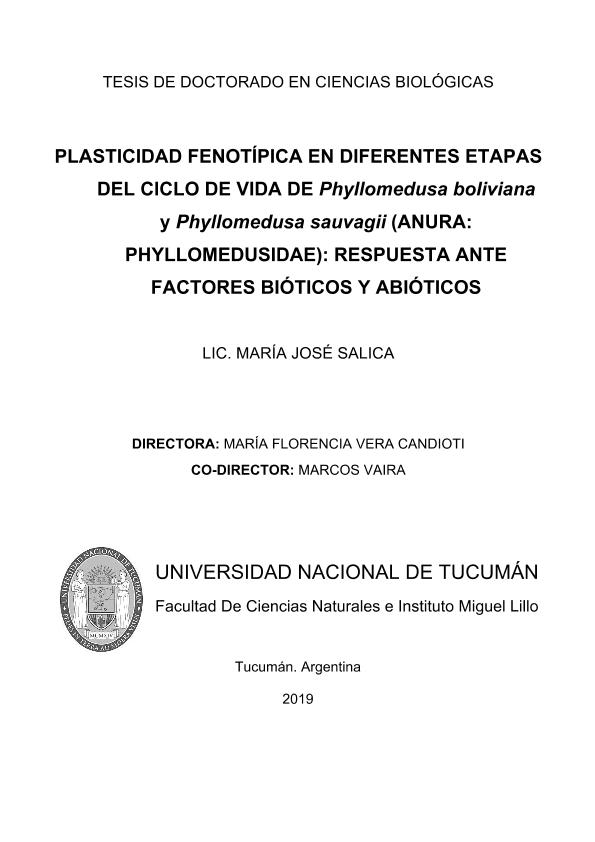Tesis doctoral
Los anuros presentan un ciclo de vida complejo caracterizado por puntos de transición que involucran profundos cambios morfológicos, fisiológicos, ecológicos y comportamentales. La eclosión y la metamorfosis representan eventos cruciales, y tanto éstos como las etapas que delimitan pueden presentar variaciones morfológicas y ecológicas en respuesta a cambios en el ambiente, lo que se conoce como plasticidad fenotípica. A su vez, la plasticidad en etapas tempranas del desarrollo puede producir consecuencias en etapas subsecuentes. Con el objetivo de estudiar de manera integrada el ciclo de vida anuro, las etapas que lo caracterizan, y sus relaciones con variables ecológicas, empleamos como modelo dos especies de ranas mono, Phyllomedusa sauvagii y P. boliviana (Phyllomedusidae). El proyecto enfatiza en el desarrollo embrionario y larval, la eclosión y la metamorfosis, y cómo éstos varían en respuesta a estímulos bióticos y abióticos. Para esto se realizaron diseños experimentales en laboratorio y mesocosmos, sometiendo individuos en diferentes etapas ontogenéticas a condiciones variables de depredación e hidroperíodo, y comparando las respuestas fenotípicas con series de individuos control. Las observaciones en condiciones normales muestran que el desarrollo embrionario es muy similar al de otros phyllomedusidos, con algunas diferencias en la configuración de las glándulas adhesivas y de eclosión. Ambas especies presentan la capacidad de adelantar el momento de eclosión en respuesta a la inundación de sus nidos. Si bien los embriones que eclosionan precozmente muestran un menor desarrollo que los que eclosionarán normalmente, el ingreso temprano al agua acelera el incremento de tamaño y desarrollo del sistema respiratorio y digestivo. Estas diferencias son evidentes al comienzo de la vida libre, pero se desdibujan a medida que avanza el desarrollo. Las larvas alteran su fenotipo en respuesta a señales de depredación e hidroperíodo y estas respuestas difieren dependiendo de la especie y la edad de eclosión. En P. boliviana el desarrollo es en general más susceptible a las señales de depredación, con cambios morfológicos que se concentran al inicio de la etapa larval y se mantienen produciendo una metamorfosis más lenta y a mayor tamaño. Por su parte, en P. sauvagii los efectos de la depredación y aparentemente de los cambios en el hidroperíodo se compensan hacia el final del desarrollo. Estos resultados son semejantes a los encontrados en una especie relacionada, y subrayan que el desarrollo es crítico en etapas posteclosión. En P. boliviana esto trae consecuencias acumulables a etapas posteriores, mientras que en P. sauvagii la mayor resistencia a los cambios podría relacionarse a los ambientes comparativamente más inestables que explota. Este estudio representa un trabajo inédito en la región, y contribuye a ampliar la comprensión sobre factores ambientales que afectan dinámicas poblacionales, dando lugar a una gran variedad de líneas de investigación futuras. Anurans have complex life cycles characterized by transition points that involve deep morphological, physiological, ecological and behavioral changes. Hatching and metamorphosis represent crucial points, and both these and the stages they delimit can present morphological and ecological variations in response to changes in the environment, knowing as phenotypic plasticity. In turn, plasticity in early stages of development can produce consequences in subsequent stages. With the objective of studying in an integrated way the anurous life cycle, the stages that characterize it, and its relations with ecological variables, we use as model two species of monkey frogs, Phyllomedusa sauvagii and P. boliviana (Phyllomedusidae). The project emphasizes embryonic and larval development, hatching and metamorphosis, and how these vary in response to biotic and abiotic stimuli. For this, experimental designs were made in the laboratory and mesocosms, subjecting individuals in different ontogenetic stages to variable conditions of predation and hydroperiod, and comparing the phenotypic responses with series of control individuals. Observations under normal conditions show that the embryonic development is very similar to that of other phyllomedusids, with some differences in the configuration of the adhesive and hatching glands. Both species have the capacity to advance the moment of hatching in response to the flooding of their nests. Although embryos that hatch early show less development than those that normally hatch, early entry into the water accelerates the increase in size and development of the respiratory and digestive systems. These differences are evident at the beginning of free life, but become blurred as development progresses. The larvae alter their phenotype in response to signs of predation and hydroperiod and these responses differ depending on the species and age of hatching. In P. boliviana development is generally more susceptible to signs of predation, with morphological changes that are concentrated at the beginning of the larval stage and continue to produce a slower metamorphosis and larger. On the other hand, in P. sauvagii the effects of the predation and apparently of the changes in the hydroperiod are compensated towards the end of the development. These results are similar to those found in a related species, and underline that development is critical in post-hatching stages. In P. boliviana this brings cumulative consequences to later stages, while in P. sauvagii the greater resistance to changes could be related to the comparatively more unstable environments that it exploits. This study represents unprecedented work in the region, and contributes to broadening the understanding of environmental factors that affect population dynamics, giving rise to a wide variety of future research lines.
Plasticidad fenotípica en diferentes etapas del ciclo de vida de Phyllomedusa boliviana y Phyllomedusa sauvagii (Anura: Phylllomedusidae): Respuesta ante factores bióticos y abióticos
Salica, María José

Director:
Vera Candioti, María Florencia

Codirector:
Vaira, Marcos

Fecha de publicación:
04/07/2019
Idioma:
Español
Clasificación temática:
Resumen
Palabras clave:
Ontogenia Temprana
,
Eclosión Plástica
,
Efecto acumulativo
,
Anfibios
Archivos asociados
Licencia
Identificadores
Colecciones
Tesis(INECOA)
Tesis de INSTITUTO DE ECORREGIONES ANDINAS
Tesis de INSTITUTO DE ECORREGIONES ANDINAS
Citación
Salica, María José; Vera Candioti, María Florencia; Vaira, Marcos; Plasticidad fenotípica en diferentes etapas del ciclo de vida de Phyllomedusa boliviana y Phyllomedusa sauvagii (Anura: Phylllomedusidae): Respuesta ante factores bióticos y abióticos; 4-7-2019
Compartir



